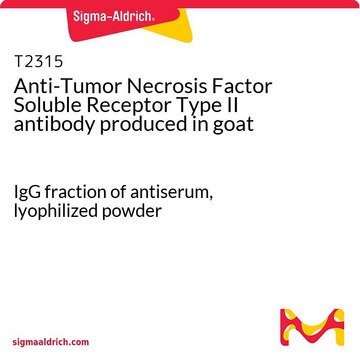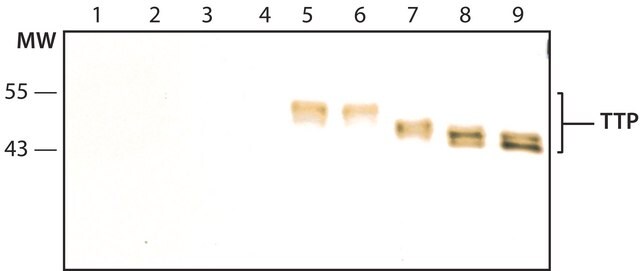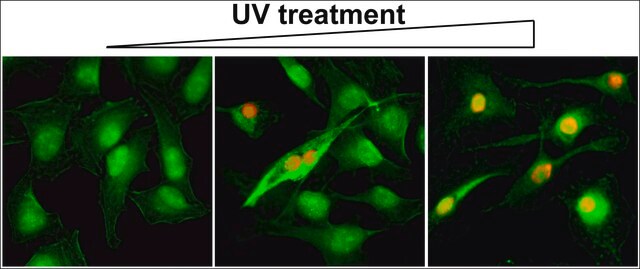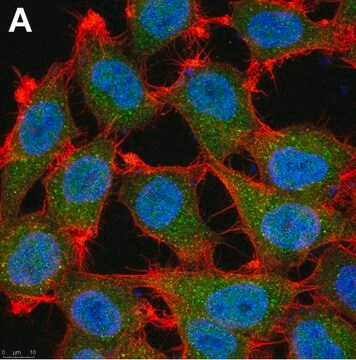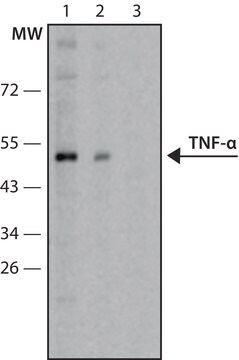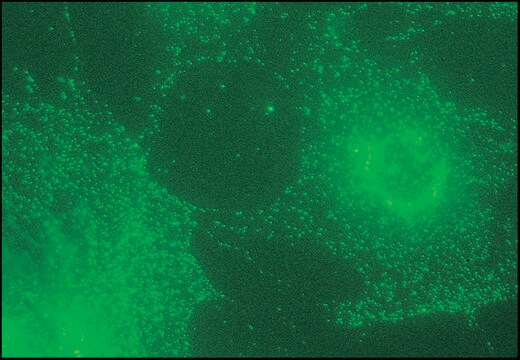추천 제품
생물학적 소스
mouse
Quality Level
결합
unconjugated
항체 형태
purified immunoglobulin
항체 생산 유형
primary antibodies
클론
22221, monoclonal
양식
lyophilized powder
종 반응성
human
기술
immunocytochemistry: 8-25 μg/mL using immersion fixed human peripheral blood lymphocytes
microarray: suitable
neutralization: suitable
동형
IgG2a
UniProt 수납 번호
저장 온도
−20°C
타겟 번역 후 변형
unmodified
유전자 정보
human ... TNF(7124)
일반 설명
The tumor necrosis factor super family (TNFSF) consists of at least 19 transmembrane proteins with soluble forms that are generated by proteolysis. The biological effects of TNF are mediated by either type I or type II receptors. Type I receptors that are ubiquitously present on all cells whereas type II receptors are expressed only on cells of immune system (monocytes, macrophages, Langerhans cells) and endothelial cells. Receptors of TNFSF such as TNFR I and Fas have their own death domains that activate the apoptosis. Other receptors such as TNFR II do not have death domains and utilize TNF associated factors (TRAFs) to activate intracellular signaling. TNFR II activates NF-κB pathway via the activation of NIK. Monoclonal Anti-Tumor Necrosis Factor Receptor II antibody recognizes human TNFR II.
특이성
The antibody neutralizes the biological effect of recombinant human TNF RII. It does not neutralize or cross-react with TNF RI.
면역원
recombinant human tumor necrosis factor receptor II, expressed in Escherichia coli.
애플리케이션
Anti-Tumor Necrosis Factor Receptor II antibody may be used for immunocytochemistry at a working concentration of 8-25 μg/ml using human peripheral blood lymphocytes. The antibody is suitable for neutralization assays and protein microarray. The antibody was used for flow cytometry using human CD8 T cells.
물리적 형태
Lyophilized from a 0.2 μm filtered solution in phosphate buffered saline containing carbohydrates.
제조 메모
Purified using protein A
면책조항
Unless otherwise stated in our catalog or other company documentation accompanying the product(s), our products are intended for research use only and are not to be used for any other purpose, which includes but is not limited to, unauthorized commercial uses, in vitro diagnostic uses, ex vivo or in vivo therapeutic uses or any type of consumption or application to humans or animals.
적합한 제품을 찾을 수 없으신가요?
당사의 제품 선택기 도구.을(를) 시도해 보세요.
Storage Class Code
12 - Non Combustible Liquids
WGK
WGK 1
Flash Point (°F)
Not applicable
Flash Point (°C)
Not applicable
Liqin Ban et al.
Proceedings of the National Academy of Sciences of the United States of America, 105(36), 13644-13649 (2008-08-30)
Human autoimmune (AI) diseases are difficult to treat, because immunosuppressive drugs are nonspecific, produce high levels of adverse effects, and are not based on mechanistic understanding of disease. Destroying the rare autoreactive T lymphocytes causing AI diseases would improve treatment.
The Role of Costimulatory Receptors of the Tumour Necrosis Factor Receptor Family in Atherosclerosis
Antunes RF et al
Journal of Biomedicine and Biotechnology, doi: 10-doi: 10 (2012)
B B Aggarwal
Annals of the rheumatic diseases, 59 Suppl 1, i6-16 (2000-10-29)
Tumour necrosis factor (TNF) is a pleiotropic cytokine that mediates apoptosis, cell proliferation, immunomodulation, inflammation, viral replication, allergy, arthritis, septic shock, insulin resistance, autoimmune diseases, and other pathological conditions. TNF transduces these cellular responses through two distinct receptors: type I
M Lotz et al.
Journal of leukocyte biology, 60(1), 1-7 (1996-07-01)
Receptors in the nerve growth factor/tumor necrosis factor receptor family are characterized by the presence of cysteine-rich motifs of approximately 40 amino acids in the extracellular domain. The ligands are type II transmembrane proteins with beta-strands that form a jelly-roll
Joana Gonçalves et al.
The European journal of neuroscience, 31(2), 315-326 (2010-01-16)
Methamphetamine (METH) causes irreversible damage to brain cells leading to neurological and psychiatric abnormalities. However, the mechanisms underlying life-threatening effects of acute METH intoxication remain unclear. Indeed, most of the hypotheses focused on intra-neuronal events, such as dopamine oxidation, oxidative
자사의 과학자팀은 생명 과학, 재료 과학, 화학 합성, 크로마토그래피, 분석 및 기타 많은 영역을 포함한 모든 과학 분야에 경험이 있습니다..
고객지원팀으로 연락바랍니다.